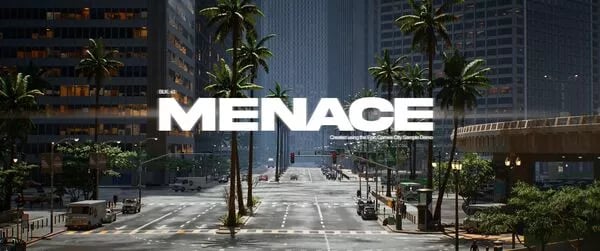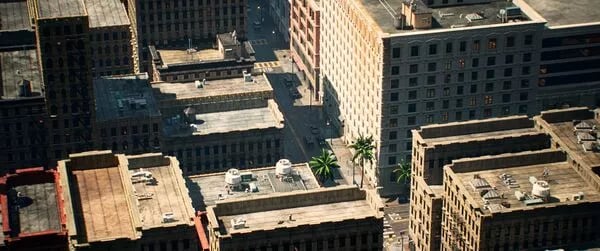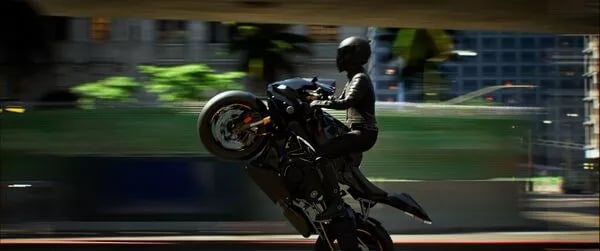You may remember Ewald from when he had just started the Real-time 3D Foundations course and created his first impressive cinematic, Haven. He has now graduated and, since our last interview, has gone on to create an even more...
You may remember Ewald from when he had just started the Real-time 3D Foundations course and created his first impressive cinematic, Haven. He has now graduated and, since our last interview, has gone on to create an even more ambitious project, Menace.
We sat down with Ewald to discuss the making of his latest project, how he's progressed as an artist, the impact of the ongoing support of his mentors and the CG community throughout his studies, and his aspirations for the future.
Hi again, Ewald! Tell us about your latest cinematic, Menace.
Menace is a captivating, high-octane, real-time 3D action cinematic about a reckless motorcyclist evading the pursuit of police in a tropical cityscape. The success of Menace has no doubt solidified my direction within the 3D cinematic space.

Title screen for Ewald's cinematic in Unreal Engine.
I'm excited to share that Menace got selected as a finalist for The Rookie Awards 2023, as well as a DNEG finalist.
It has generated over 343,000 views on YouTube. I've been featured on the VFX Process Youtube Podcast to talk about the creation of Menace, and it was also featured on IGN - Future Games show channel.
Menace generates about 15K views a week on YouTube.
Talk us through how Menace was made.
What started as a two-week previz class to learn Unreal Engine’s 'Take Recorder' quickly transformed into a full-on action cinematic and, ultimately, Menace.
When I started learning Unreal Engine, one of the most important things I wanted to experiment with was trying to recreate an engaging action scene and capture the same energy as you would with a live-action shoot since this is a big part of my career experience.
I chose the City Sample Demo because it already looks amazing, and since the class lessons were in using the Take Recorder instead of environment building, this seemed like a win for my time spent and potentially having something cool for my portfolio.
I knew that if I could get the simulation capture process figured out in the City Sample Demo, I could make my own environment in the future and use the same workflow.
I conducted research and gathered references of inspiring chase scenes and other Unreal artists' work. I found a great-looking sports bike in the Unreal Marketplace. The blueprint was already rigged with a Metahuman, and the riding physics seemed perfect for what I needed.
One of the most fun parts was doing virtual location scouting of the City Sample Demo, and I found the perfect straight section with enough room for the action to happen comfortably while also keeping my camera focal lengths in mind.

City Sample Demo 3D environment.
I then created a new project and empty level, built the width of that straight section and started recording the motorcycle and vehicle actions using game mechanics and take recorder.
This process was fun, as you're pretty much playing a racing game with a PS4 controller on an empty map.
I imported the recorded takes into the City Sample Demo and started placing the actors. The plan was to have a three-to-four-shot sequence. Every step of the way, I surprised myself with the result I was getting and got more and more excited. Coming from a directing and video editing background, I really enjoyed this process and basically built the story as I went.
After each shot, I would think about what would help the flow and momentum into the next shot. I quickly learned that I really love building virtual cinematics and placing cameras and got carried away. In the end, I had over 40 different camera angles in four different locations.
[featured]
How did the CG Spectrum mentors help with the process?
The knowledge I gained from my mentors, Deepak Chetty and Simon Warwick, during the cinematics part of the course I can compare to someone handing over the keys to a Ferrari. Combine this with the control you have at your fingertips in Unreal Engine, I quickly started feeling at home.
I was blessed to get Deepak Chetty as my mentor during the cinematics part of the course.
There were a lot of backend challenges with using the motorcycle and vehicles in the City Sample Demo, and working with an Unreal Engine master like Deepak really kept the excitement going.
Someone I can't thank enough is the CG Spectrum Head of Real-time, Simon Warwick. I showed him my first cut, and he had very valuable animation suggestions.
Looking back now, I don't think the cinematic would have got the attention it did if it wasn't for Simon. He assisted me in animating the character movements and giving it a more natural feel.

CGS mentor Simon Warwick, helped Ewald to create a more natural animation for the main character.
I was a little intimidated as it's not something I've ever done at this scale. The process in Unreal Engine felt very intuitive, and I found myself getting carried away again and really enjoyed that process. Another extremely valuable piece to the puzzle for a project of this scale was setting up Perforce source control, and after spending a few days in the trenches, Simon assisted me in getting the set-up so I could render on an older system while still working. Now, I can't live without it.
You have a good relationship with the CG Spectrum community - how did that help your project?
The CG Spectrum community has been a major boost for my work. I love having a place I can go to and share work in progress, receive other artists' thoughts, and get honest feedback and input. There are no questions too simple or hard; everyone is going through or has gone through the same hurdles you are. Having such an enthusiastic group of students, TAs, and mentors has been invaluable.
What's next for you?
I am excited to say that I finished my Real-time 3D Foundations course, and throughout this process, I was unsure of where I would fit in with my previous career experience in film and video production. Menace has changed that for me.
I am wholeheartedly pursuing becoming a virtual production cinematic director and artist.

Taking the leap into studying real-time 3D and virtual production has no doubt been one of the best decisions I could have made for my career.
To see more of Ewald's work, follow him on YouTube and Instagram.
Study virtual production and become a real-time 3D artist!
At CG Spectrum, you'll have plenty of opportunities to put your skills to the test and create your very own cinematic masterpiece, just like Ewald did! Our team of industry professionals will guide you in real-time 3D, immersing you in the art of world building, digital character animation, and the mastery of advanced lighting and camera techniques.
These real-time 3D technical skills are a game-changer, benefiting not just game developers and content creators, but also traditional filmmakers looking to seamlessly transition their expertise into the exciting world of virtual production.
Join the future of filmmaking, content creation, and game development!












